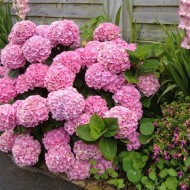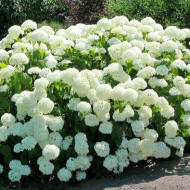Features and rules of planting and caring for hydrangea in the harsh conditions of Siberia
Content
Suitable varieties for Siberia
Botany has more than 30 types of hydrangeas, but only some of them are suitable for growing in Siberia. Seedlings are best purchased from local growers who have grown them on their site. In order for the plant to bloom, varieties of the earliest flowering period are chosen.
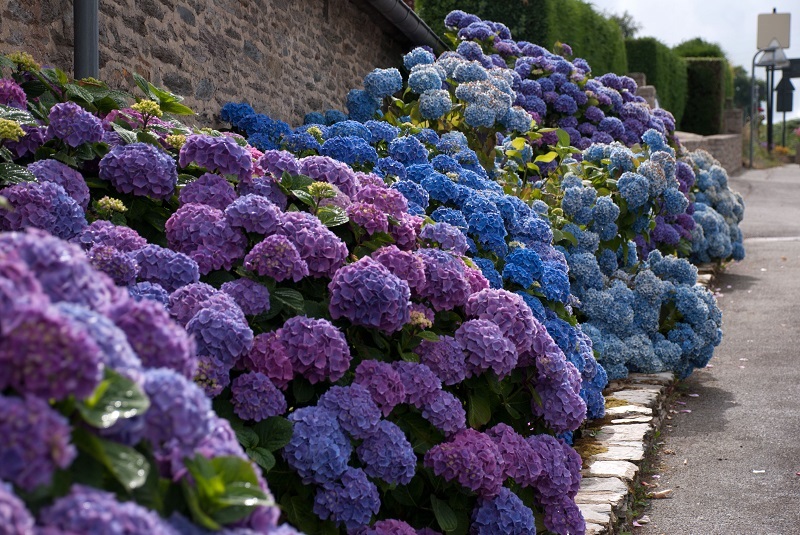
Winter hardy varieties
Not every flower can withstand temperatures down to -40 ° C. The following varieties are the most resistant to frost:
- Silver Dollar. Tall shrub (up to 3 m) begins to bloom by mid-summer. Lush snow-white cone-shaped inflorescences acquire a delicate pinkish tint by the beginning of autumn.
- Pinky Winky. A panicle type of hydrangea up to 2.5 m high. The flowering period begins in June and lasts until mid-autumn. Over the entire period, the inflorescences alternately change their tone from white to burgundy.
Tree hydrangea
In addition to frost resistance, this type of hydrangea has an increased immunity to diseases. Gardeners prefer to plant these tree-like varieties:
- Annabelle. The plant can withstand cold temperatures down to -30 ° C. The average height of the shrub is 1.2–1.5 m. The hydrangea begins to bloom not earlier than June with snow-white clusters.
- Strong Annabelle. A variety with original dome-shaped inflorescences. Over the entire flowering period, they change their shade from white to light green. The shrub grows up to 1.3 m and is able to withstand frosts down to -35 ° C.
- Invincibelle Spirit. Winter-hardy hydrangea tolerates temperatures down to -38 ° C. Plant height is 1–1.3 m. From June to September, the shrub is covered with large clusters of crimson hue.
- Grandiflora. Tall variety (2-3 m) resistant to frost down to -30 ° С. It blooms in large snow-white inflorescences with a diameter of 30 cm with a pale pink and cream shade.
Paniculata varieties
Medium-sized species, which has pubescent leaf plates and fragrant inflorescences. The most common varieties are:
- Vanilla Fresh. It grows up to 1.5 m. The flowering period is in the middle of summer. Within 3 months, the brushes change their shade from snow-white to dark red.
- Sanday Fresh. The plant is 1 m high with very large, weighty inflorescences of chameleon color (from white to dark carmine shade). The shrub blooms all summer.
- Medical Fire. A fairly winter-hardy plant that grows up to 2 m. During flowering, the hydrangea seems to be engulfed in flames - its brushes are painted in white, crimson and scarlet shades.
- Limelight. Withstands temperatures down to -30 ° C. The height of the bush is 1.8 m. Lush lemon inflorescences bloom from July to September. By autumn, they acquire a pinkish tint.
- Unique. The variety is also able to withstand cold temperatures down to -30 ° C. The maximum height is 2 m. Hydrangea blooms from mid-summer to early autumn in a snow-white or pale pink color.
Large-leaved hydrangea
Garden hydrangea is a late flowering plant. Most often, gardeners choose the following varieties for giving:
- Endless Summer. A tall plant (4 m) tolerates temperatures down to -25 ° C. Flowering begins in August and continues through November. Spherical brushes are dominated by white, lavender, pale blue shades.
- Forever & Ever. A low-growing variety with a height of 1 m is resistant to frost down to -25 ° C. From August to October it is covered with large blue "balls", which gradually change color to purple.
- You and Me Together. A compact hydrangea that grows only up to 80 cm. It is distinguished by its “chameleon” foliage. Its green color changes over time to orange and then turns reddish-brown. Inflorescences are painted in white, pinkish or pale blue tones. Blooms from August to October.
- Hovaria. The variety does not like harsh winters and tolerates temperatures only up to -18 ° C. Blooms in large globular blue inflorescences with a purple tint. The maximum height of the bush is 4 m.
- Schloss Wackerbart. Withstands frosts down to -28 ° C and grows up to 1.3 m. It differs in inflorescences of different shades - from light green to pale pink. By the end of September, they become dark carmine. Hydrangea blooms in mid-summer.
- Winter hardy
- Large-leaved
- Paniculata
- Tree-like
Video "Growing hydrangea in Siberia"
This video tells about the features of planting and caring for an ornamental shrub.
Features of agricultural technology in Siberia
There is no need to be afraid to grow hydrangea in the harsh conditions of Siberia. If you plant a seedling, taking into account the nuances of the local climate, then its acclimatization will be quick, and the flowering will be abundant.
Choice of location, soil and lighting
For planting shrubs, gardeners recommend choosing lighted areas with little shadow. The place should not be blown by winds, without drafts. The plant will feel comfortable in a slightly acidic, fertile environment. The ideal soil mixture is leafy soil, peat, turf and sand. Also, hydrangea grows well on the ground from under coniferous trees.
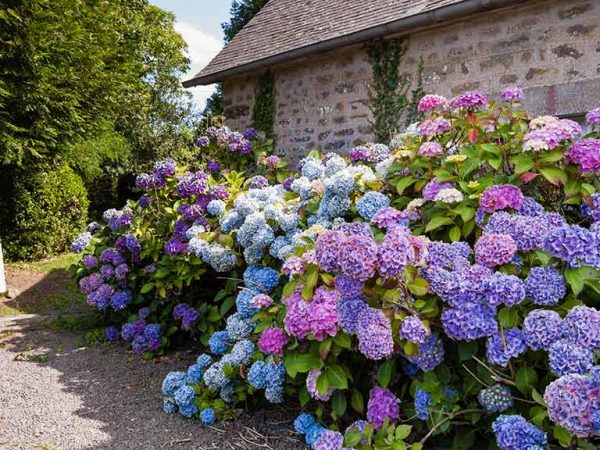
Planting pit preparation
The "youngsters" are disembarked in the second decade of May. The place is prepared in advance, following a few simple rules:
- the size of the recess is made 50x50x60 cm at a distance of 2.5 m from each other;
- 3 buckets of water are poured into the pit and left for a day;
- a soil mixture is prepared from earth, peat, sand, humus, to which potassium-phosphorus fertilizers are added;
- fall asleep the resulting substrate, forming a small mound.
Planting scheme for seedlings
Hydrangea cultivation begins with the correct planting of the seedling. The algorithm of action includes several steps:
- The branches are slightly pruned to a young plant, leaving only a couple of buds.
- Having placed in the planting hole, the rhizome is carefully straightened.
- Filled with prepared soil mixture and tamped.
- Pour 20 liters of water under the bush.
- A mulch layer of needles, dry leaves, peat or sawdust is covered.
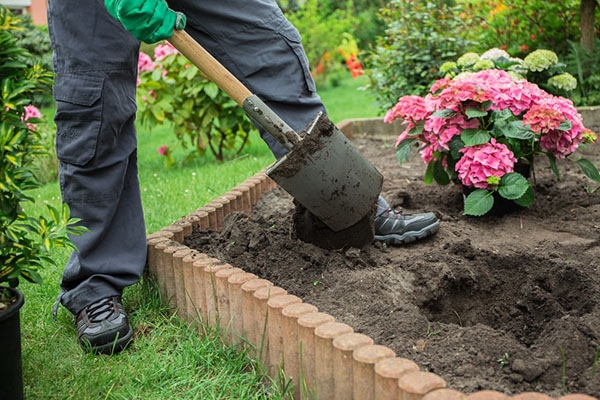
Watering, fertilizing and feeding
A moisture-loving flower requires abundant regular watering. Once every 2 weeks, up to 20 liters of water is poured under the bush, and in dry weather the interval is halved. If the summer is rainy, irrigation is reduced to 5 procedures for the entire season.
Top dressing is carried out several times:
- beginning and end of spring with an interval of 2 weeks - potassium-phosphorus compositions;
- budding period - potassium sulfate in combination with superphosphate;
- at the end of flowering - organic fertilizers.
Pruning and shaping the crown
Hydrangeas growing in Siberia should be pruned regularly. This is done when the plant has reached 3 years of age. The first procedure is carried out before the juices begin to move - the shoots are shortened to 3 buds.To form the crown, remove weak branches, as well as those that do not grow properly. To rejuvenate the shrub, the entire upper part is cut off, leaving shoots 5 cm long.

Shelter and preparation for the winter
Before wintering, faded inflorescences are removed from the plant, dry branches are cut off. Dig up the ground under the bush and lay out a layer of mulch. The hydrangea wrapped in spandbond is placed in a horizontal position, and covered with needles, dry grass or sawdust on top.
Tall or too bushy specimens are neatly tied and wrapped with frame wire, forming a kind of hut. It is filled with dry foliage, and then covered with roofing material.
Experienced gardeners recommend throwing a snowdrift on a covered hydrangea to keep it warm.
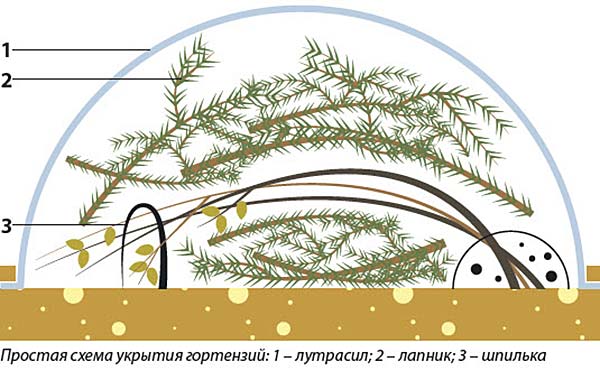
Breeding methods for hydrangeas in the garden
Hydrangea propagation can be done in several ways:
- Seeds. Due to the harsh climate, this method is not in demand. Before planting a seedling in a permanent place, it is grown for several years in containers.
- Cuttings. A shoot with 3 buds is cut off from an adult plant, which is placed in Kornevin's solution for a couple of hours. The planted shoots are covered with polyethylene, and taken from open ground for the winter. In early spring, the seedling is returned to its permanent place.
- Layers. The procedure is carried out immediately after the end of winter. The lower stems are placed in pits 2 cm deep, leaving the top on the surface, and sprinkled with earth on top. When the shoots take root, they are separated from the donor plant and transplanted.

Disease and pest control
Hydrangea is quite resistant to disease, but sometimes it is susceptible to powdery mildew or chlorosis. At the first signs of infection, the plant is treated with a targeted fungicide solution.
Often a spider mite or aphid grow on the bush. Pest attacks can be prevented with insecticide treatments.
Whichever varieties you choose for planting, hydrangea requires special care in the climate of Siberia. Observing all agrotechnical rules, you can achieve abundant and bright flowering even under the most severe conditions.


